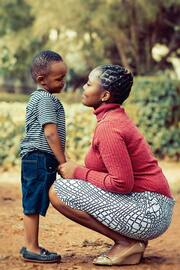|
Back to Blog
 Photo by Nicholas Githiri on Pexel Photo by Nicholas Githiri on Pexel If you’re a parent, you’ve probably heard about the importance of developing an attachment with your child. It’s especially important when your little one is a baby, in their first 18 months of life. Okay – so we know it’s important. But what, exactly, does “attachment” mean? How do you know if your child is “attached,” and whether or not that attachment is a healthy one? In the world of mental health, we’re referring to something specific when we talk about parent-child attachment. This concept is rooted in attachment theory, which was developed in the 1960s by a psychologist named John Bowlby. According to attachment theory, we all develop one of 4 attachment styles to our caregivers as young children. These attachment styles continue to affect us through our lives and into our adult relationships. Adults with secure attachment tend to have higher self-esteem, better mental health, and healthier relationships. Secure attachment tends to form within the first 18 months of life. But even if – for whatever reason – your child wasn’t able to form a secure attachment early in their infancy, that doesn’t mean that all hope is lost. And vice versa: Even if your child did develop a secure attachment as a baby, that attachment can still be affected by your relationship later in their life. In today’s blog, I want to share some information about what different attachment styles can look like in young children, and how to start developing (or continuing to strengthen) a secure attachment as your child gets older. What are the 4 attachment styles? Attachment styles are split up into two umbrella categories: secure and insecure. Secure attachment is the healthiest form of attachment – what we’re all striving for with our kids. When your child is securely attached to you, they care about your opinion and presence – but they also trust you enough to be able to do some things on their own. In a young school-aged child, some signs of secure attachment might be:
Insecure attachment is an umbrella that includes 3 different attachment styles: anxious-ambivalent, avoidant, and disorganized. Kids with an anxious-ambivalent attachment style have a hard time trusting. In young kids, this might look like:
Kids with an avoidant attachment style reject their caregivers; it’s almost like they want to reject you before you can reject them. Kids with an avoidant attachment style often:
Kids with disorganized attachment show a mix of both avoidant and anxious-ambivalent behaviors. What causes insecure vs. secure attachment? A child’s attachment style is mostly based on parenting style and early childhood experiences. For example, a child who has gone through a separation with their parent(s) might develop an anxious attachment style. A child who has an emotionally absent or unresponsive parent might develop an avoidant attachment style. But instead of focusing on the negatives, let's focus on the positive - what leads to a secure attachment style. Parents of securely attached kids tend to:
So does your behavior matter to your child? Absolutely. That doesn’t necessarily mean it’s your “fault” if your child has developed an insecure attachment. There are so many variables. Maybe you lived with an illness when your child was an infant, which prevented you from being fully present. Maybe there was a separation that was out of your control. Let's not also forget to mention that none of us were given a parenting how-to manual when our kids were born. Most of us end up simply repeating what we observed our parents doing when we were young – and they weren’t given manuals, either. If we, ourselves, had/have an insecure attachment, then that’s probably affected the way we parent our kids. In any case, I’m not here to point fingers and find the person “responsible” for an insecure attachment. The important thing is to assess your own attachment style, your child’s attachment style and figure out the best way to move forward. How to work on building a secure attachment with your child No matter where you are on this journey, there are ways to build and strengthen a secure attachment with your child. And remember – this isn’t just about your relationship with them. It’s about the way they will relate to others for their lives to come. The first step is to figure out what attachment style your child does have. If you aren’t sure, I offer the Marschak Interaction Method assessment for almost every family I work with. This is an evidence-based tool that can give us some insight into what your and your child's attachment is like and what areas need to be strengthened. Second, examine your own attachment style. Like I said before, those of us who have insecure attachment styles ourselves are more likely to create that attachment style in our children. But there’s hope. Not only can you repair your child’s attachment style, you can also heal your own. Therapy can help. On top of these things, there are some other pointers to keep in mind when trying to repair the attachment with your child.
Helping our children develop a secure attachment is one of our most important tasks as parents. And no matter how old our children are, it’s never too late to start fostering this bond and helping them feel secure in the relationship they have with us. If you need some extra support, I’m here for you. Feel free to get in touch with me any time. Also head over to my support group page to learn about the latest group I am running and reach out if you are interested in joining. Wishing you much happiness and love on this Valentine’s day! Subscribe to My Blog!Get the latest parenting blog posts delivered to your inbox! Thank you!You have successfully joined mysubscriber list.
0 Comments
Read More
Your comment will be posted after it is approved.
Leave a Reply. |
This Site is not intended to provide psychotherapy advice. The Site is intended only for use by individuals in search of general information of interest pertaining to anxiety, depression and related topics. Content is not intended to replace or serve as substitute for professional consultation or service. Contained observations and opinions should not be misconstrued as specific counseling advice.
